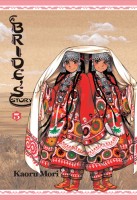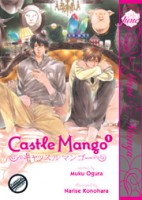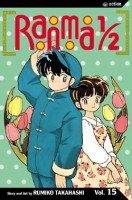My News and Reviews
Last week I announced the 4-Koma for You Winner. In case you’re looking for something to read, the post includes a list of yonkoma manga that have been released in print in English, too. I also posted December’s Bookshelf Overload last week, for those of you interested in following my adventures in buying way too much manga and other media. Finally, over the weekend I posted a review of Delavier’s Mixed Martial Arts Anatomy. This is one of the most tangentially related reviews I’ve written at Experiments in Manga. Why is it here? Simply because I’m a karateka and found it to be a useful book. It’s a great strength training resource for any martial artist. Plus, it has lots of illustrations.
I’ve more or less been on vacation for the last two weeks, so I haven’t been online much except to make sure that things were updated here at Experiments in Manga. Even so, there were two things in particular that caught my eye recently. First and foremost, the Massive anthology of gay manga originally scheduled to be published by PictureBox has been picked up by Fantagraphics! Right now, it looks like we should see the release sometime in October 2014. The other news that I was excited to hear about is that we’ll be getting a second season of the Mushishi anime nearly ten years after the first season aired. I loved Yuki Urushibara’s original manga (which is now unfortunately out-of-print in English) and I loved the first anime series so I’m looking forward to the second season a great deal.
Quick Takes
 A Bride’s Story, Volume 5 by Kaoru Mori. The art in A Bride’s Story always blows me away. Mori’s illustrations are so beautiful and detailed that it’s no surprise that there’s such a long wait in between each volume’s release. Most of the fifth volume of the series is devoted to the wedding between the twins and their husbands-to-be. The best word that I can think of to describe this volume is “joyous.” Mori shows the preparations that both families make for the happy occasion—a celebration that lasts an entire week. There’s dance and song, levity, plenty of food, and numerous guests. It’s extremely satisfying to see the entire community’s participation in the event. The manga as a whole is a gorgeous work, but the wedding itself is quite lovely. I enjoyed seeing the twins’ story develop. Their outgoing personalities might be annoying for some readers, but in the end I found the two of them to be quite endearing. Now begins the long wait for the next volume of A Bride’s Story.
A Bride’s Story, Volume 5 by Kaoru Mori. The art in A Bride’s Story always blows me away. Mori’s illustrations are so beautiful and detailed that it’s no surprise that there’s such a long wait in between each volume’s release. Most of the fifth volume of the series is devoted to the wedding between the twins and their husbands-to-be. The best word that I can think of to describe this volume is “joyous.” Mori shows the preparations that both families make for the happy occasion—a celebration that lasts an entire week. There’s dance and song, levity, plenty of food, and numerous guests. It’s extremely satisfying to see the entire community’s participation in the event. The manga as a whole is a gorgeous work, but the wedding itself is quite lovely. I enjoyed seeing the twins’ story develop. Their outgoing personalities might be annoying for some readers, but in the end I found the two of them to be quite endearing. Now begins the long wait for the next volume of A Bride’s Story.
 Castle Mango, Volume 1 written by Narise Konohara and illustrated by Muku Ogura. Despite what the cover and title page of Digital Manga’s release indicate, Konohara wrote Castle Mango while Ogura was responsible for the artwork. Konohara is the same author who wrote About Love, which I quite enjoyed, so I was interested in reading Castle Mango. Both manga are slightly atypical boys’ love stories. Instead of being straightforward man-meets-man romances, the stories are more layered. There is an emphasis on well-developed characters and actual plot; it’s not just about getting guys into bed with each other. The leads of Castle Mango are rather unusual as well. Yorozu’s family owns and runs a love hotel while Tagame is a well-known porn director. Yorozu more or less blackmail’s Tagame into a relationship in order to keep him away from his brother, but he doesn’t even really like the older man. Their story is concluded in the second and final volume of Castle Mango. I’m very curious to see how things unfold, so I’ll definitely be picking it up.
Castle Mango, Volume 1 written by Narise Konohara and illustrated by Muku Ogura. Despite what the cover and title page of Digital Manga’s release indicate, Konohara wrote Castle Mango while Ogura was responsible for the artwork. Konohara is the same author who wrote About Love, which I quite enjoyed, so I was interested in reading Castle Mango. Both manga are slightly atypical boys’ love stories. Instead of being straightforward man-meets-man romances, the stories are more layered. There is an emphasis on well-developed characters and actual plot; it’s not just about getting guys into bed with each other. The leads of Castle Mango are rather unusual as well. Yorozu’s family owns and runs a love hotel while Tagame is a well-known porn director. Yorozu more or less blackmail’s Tagame into a relationship in order to keep him away from his brother, but he doesn’t even really like the older man. Their story is concluded in the second and final volume of Castle Mango. I’m very curious to see how things unfold, so I’ll definitely be picking it up.
 A Centaur’s Life, Volume 1 by Kei Murayama. One of several “monster girl” manga recently released by Seven Seas, A Centaur’s Life is far less ecchi than the other titles. Plus, this one includes plenty of monster boys in addition to the monster girls, which I greatly appreciate. The manga is definitely centered around the series’ young women, though. The titular centaur is Kimihara Himeno; the manga is mostly a slice-of-life story which follows her and her other high school friends. (As a side note, I adore Himeno’s wild mass of hair on the cover.) Some people might find reading the first chapter a little uncomfortable as the story revolves around the girls’ privates, but following chapters are much less questionable. Overall, the manga was rather charming. And I am interested in learning more about the world that Murayama has imagined; it seems that some significant thought has been put into it. Although not the focus of the series, politics, law, cultural differences, disputes between races, and history have all been taken into consideration.
A Centaur’s Life, Volume 1 by Kei Murayama. One of several “monster girl” manga recently released by Seven Seas, A Centaur’s Life is far less ecchi than the other titles. Plus, this one includes plenty of monster boys in addition to the monster girls, which I greatly appreciate. The manga is definitely centered around the series’ young women, though. The titular centaur is Kimihara Himeno; the manga is mostly a slice-of-life story which follows her and her other high school friends. (As a side note, I adore Himeno’s wild mass of hair on the cover.) Some people might find reading the first chapter a little uncomfortable as the story revolves around the girls’ privates, but following chapters are much less questionable. Overall, the manga was rather charming. And I am interested in learning more about the world that Murayama has imagined; it seems that some significant thought has been put into it. Although not the focus of the series, politics, law, cultural differences, disputes between races, and history have all been taken into consideration.
 Ranma 1/2, Volumes 15-20 by Rumiko Takahashi. It’s been so long since I’ve read any of Ranma 1/2 that I had forgotten how much I love the series. After the main characters and basic premise are established, the manga becomes fairly episodic so it’s easy to pick up part way through the series and still know what’s going on. I find Ranma 1/2 to be hilarious and particularly enjoy the absurd martial arts that Takahashi comes up with. These particular volumes feature martial arts based around eating food extremely quickly and cheerleading, just to give two examples. I like the characters and I like the story, as silly and superfluous as it can be. Akane and Ranma seem to be no closer to getting married than they were at the beginning of the series. They argue quite a bit, but there are moments of genuine affection, too. Granted, those moments are frequently interrupted and don’t tend to last very long. The series’ off-the-wall comedy won’t be to everyone’s taste, but for me Ranma 1/2 is highly entertaining and a lot of fun.
Ranma 1/2, Volumes 15-20 by Rumiko Takahashi. It’s been so long since I’ve read any of Ranma 1/2 that I had forgotten how much I love the series. After the main characters and basic premise are established, the manga becomes fairly episodic so it’s easy to pick up part way through the series and still know what’s going on. I find Ranma 1/2 to be hilarious and particularly enjoy the absurd martial arts that Takahashi comes up with. These particular volumes feature martial arts based around eating food extremely quickly and cheerleading, just to give two examples. I like the characters and I like the story, as silly and superfluous as it can be. Akane and Ranma seem to be no closer to getting married than they were at the beginning of the series. They argue quite a bit, but there are moments of genuine affection, too. Granted, those moments are frequently interrupted and don’t tend to last very long. The series’ off-the-wall comedy won’t be to everyone’s taste, but for me Ranma 1/2 is highly entertaining and a lot of fun.
 Otome Yokai Zakuro directed by Chiaki Kon. The Otome Yokai Zakuro anime is based on an ongoing manga series by Lily Hoshino (which hasn’t been licensed in English.) The story takes place in an alternate version of Japan’s Meiji Era in which yokai and humans coexist. The office of Spirit Affairs is created in order to improve relations between the two groups. It’s made up of a small contingent of military officers and half-spirit girls who team up to work together. I’ll admit, I liked the first part of the series which explored the concerns over Japan’s Westernization and loss of traditions through the conflicts between humans and yokai much more than I did its end. Seeing as the opening has a bit of a spoiler in it, the series’ major plot twist was clearly planned well in advance, but it just didn’t seem to flow well as a whole as the narrative suddenly changes direction. The romantic subplots are broadcast from the very first episode—it’s obvious who will be falling in love with who—so none of those developments were particularly surprising or unexpected, either.
Otome Yokai Zakuro directed by Chiaki Kon. The Otome Yokai Zakuro anime is based on an ongoing manga series by Lily Hoshino (which hasn’t been licensed in English.) The story takes place in an alternate version of Japan’s Meiji Era in which yokai and humans coexist. The office of Spirit Affairs is created in order to improve relations between the two groups. It’s made up of a small contingent of military officers and half-spirit girls who team up to work together. I’ll admit, I liked the first part of the series which explored the concerns over Japan’s Westernization and loss of traditions through the conflicts between humans and yokai much more than I did its end. Seeing as the opening has a bit of a spoiler in it, the series’ major plot twist was clearly planned well in advance, but it just didn’t seem to flow well as a whole as the narrative suddenly changes direction. The romantic subplots are broadcast from the very first episode—it’s obvious who will be falling in love with who—so none of those developments were particularly surprising or unexpected, either.








